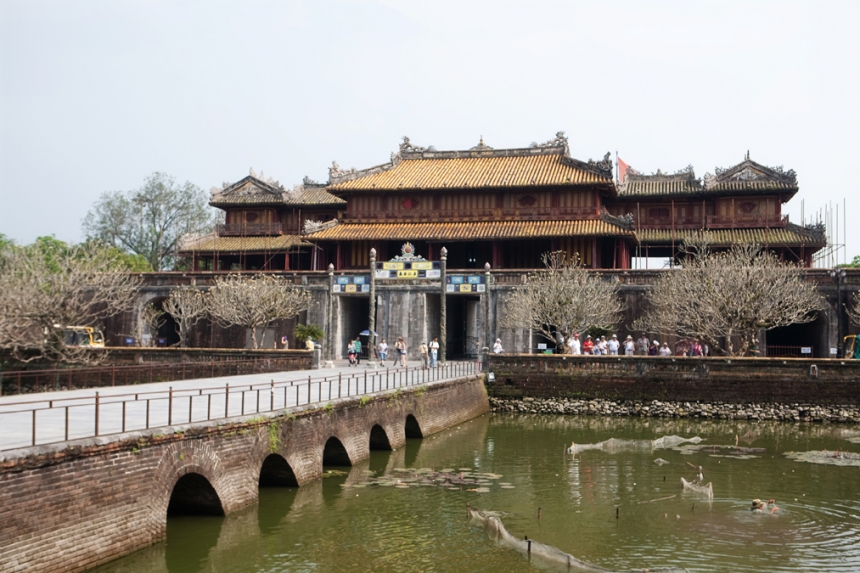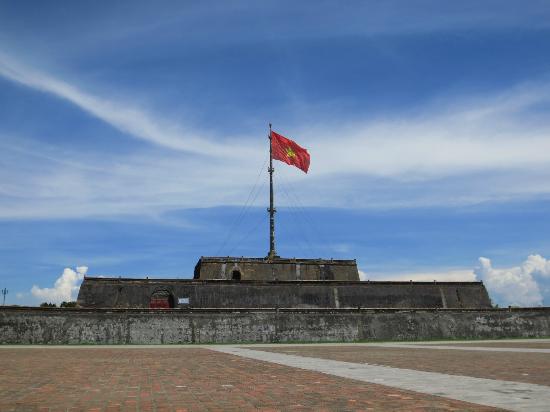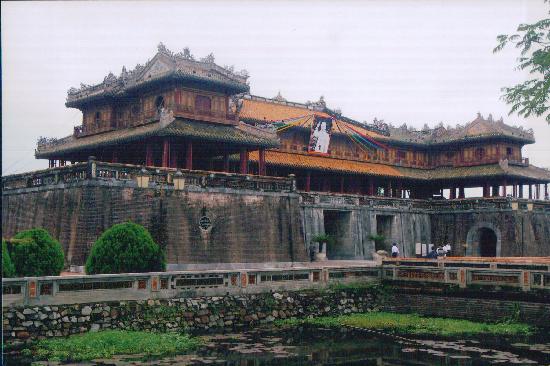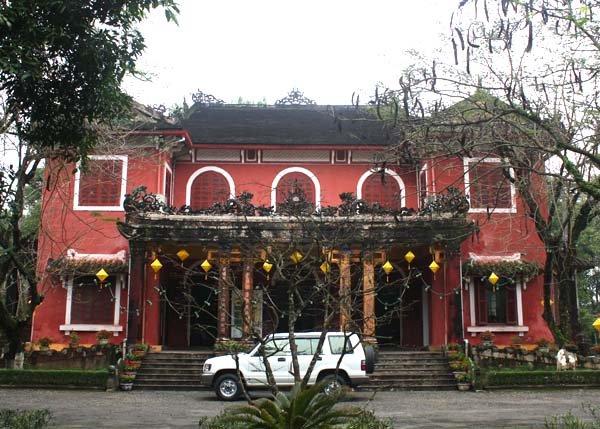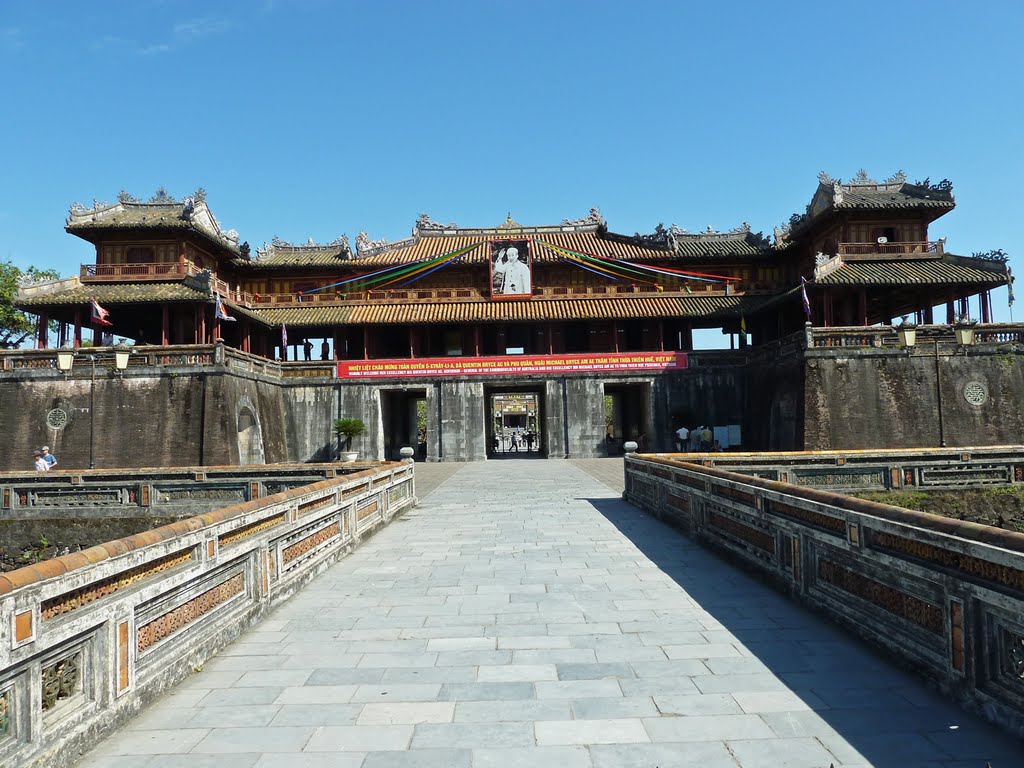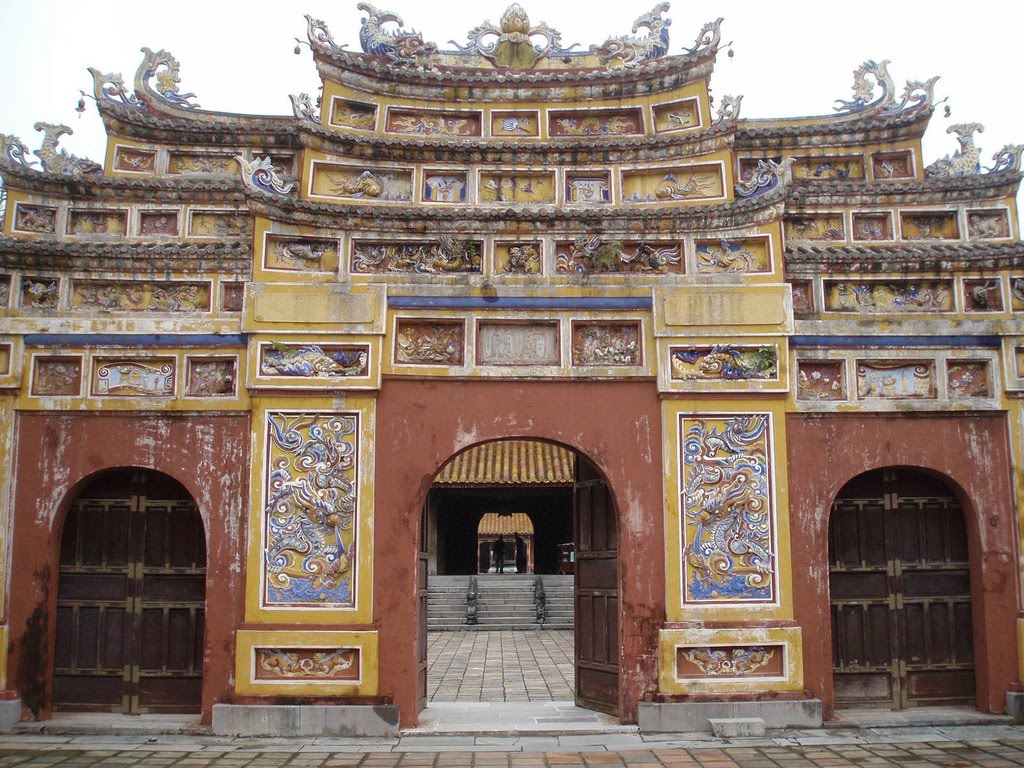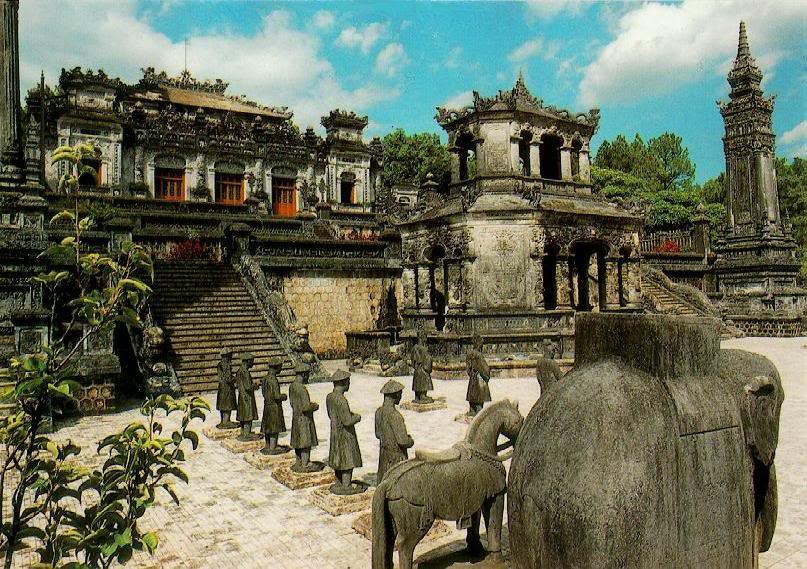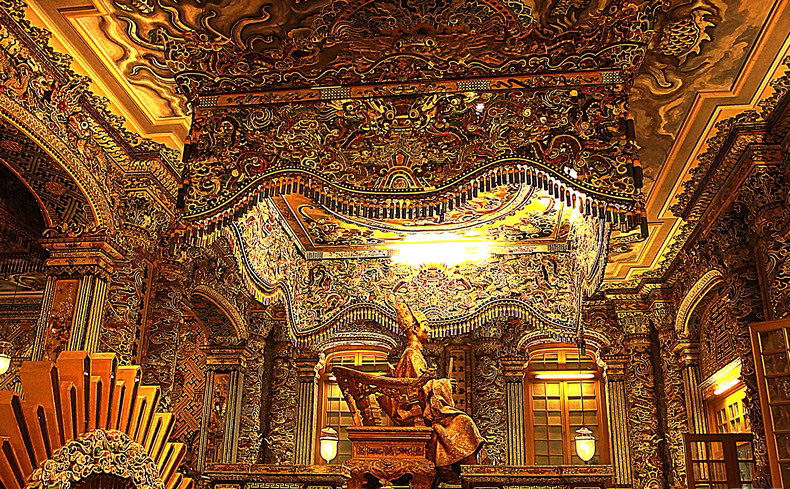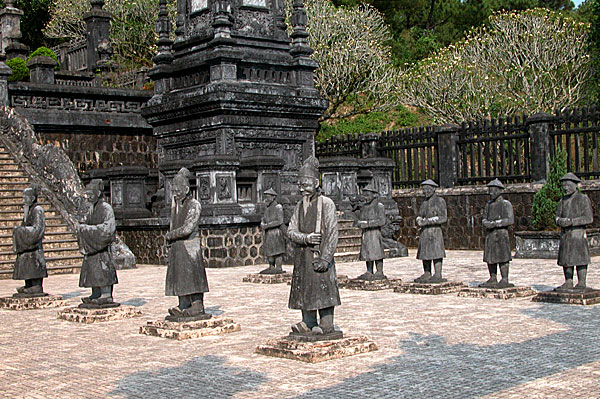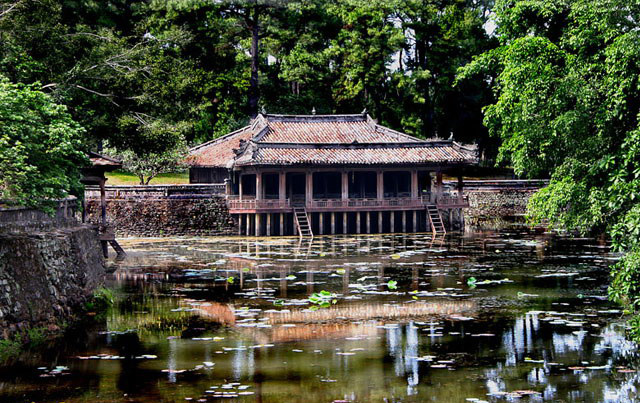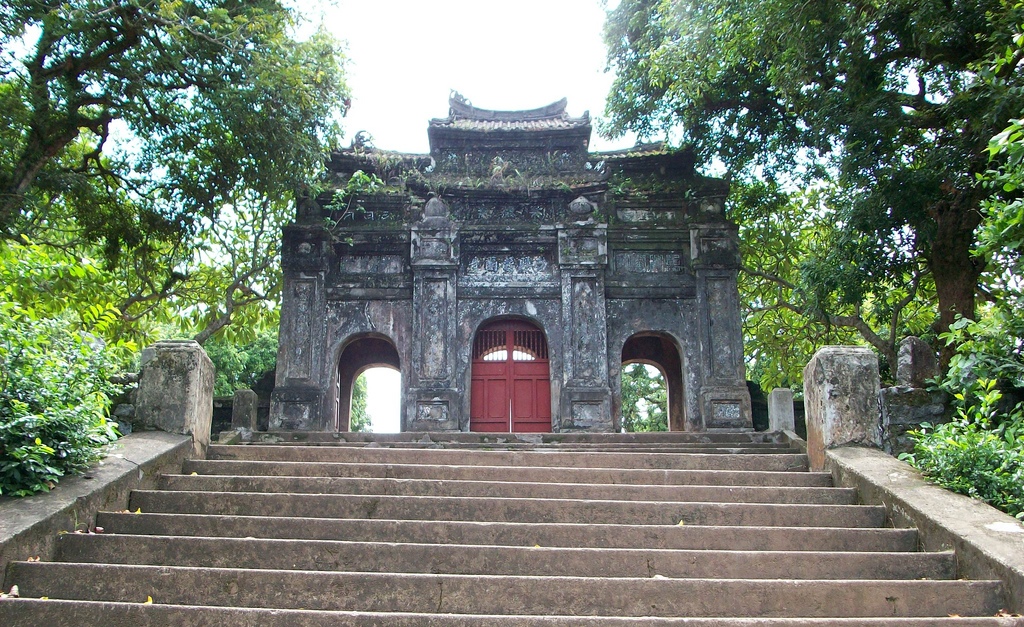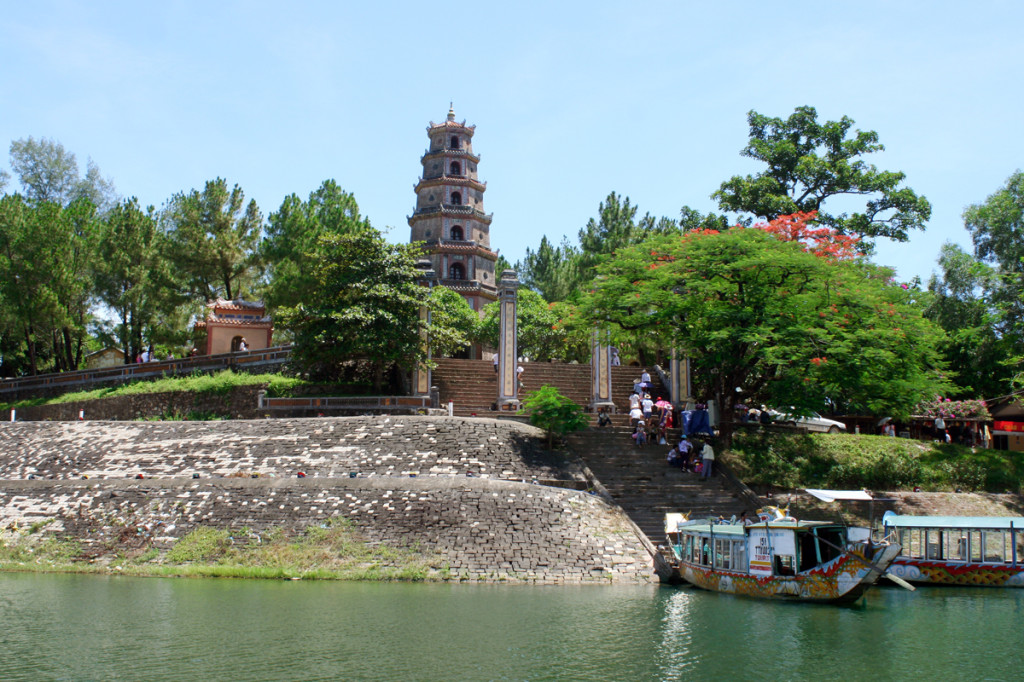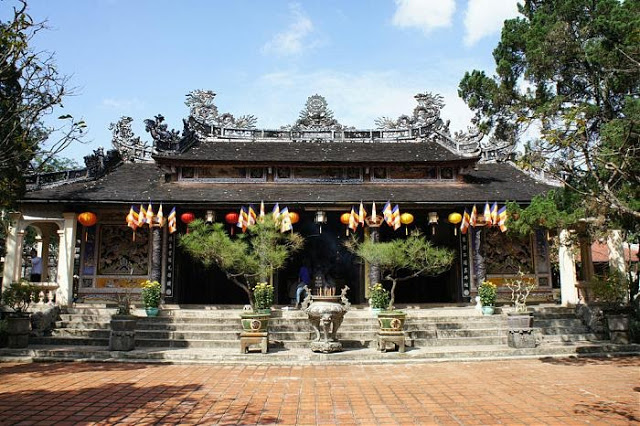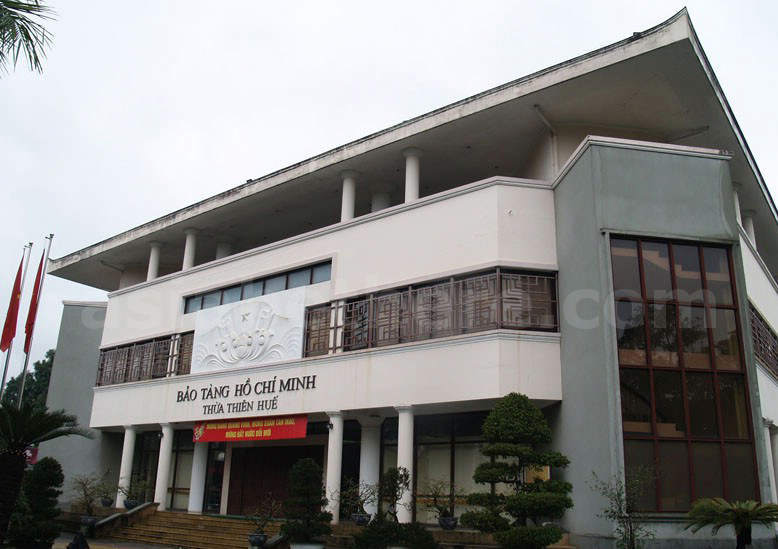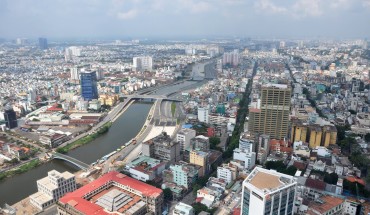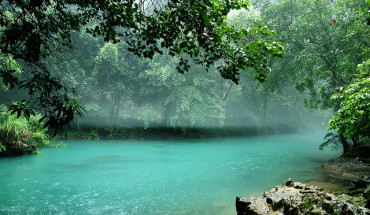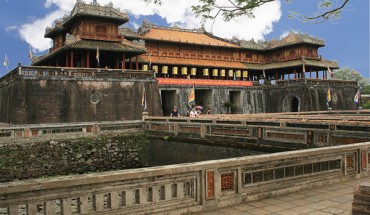Hue’s Citadel and Imperial City are the main attractions, but a visit here is usually done in conjunction with half-day trips to outlying temples and the many imperial tombs.
You might want to bicycle to the Citadel itself, then along the riverside to Thien Mu Pagoda, back to town for lunch, and then out to the tombs (distances are long, but it’s a relatively flat ride). You can also hit the sites on a self-guided tour in the comfort of a cyclo (“Pedal on, James!”). But hiring a guide see any hotel front desk -is a good idea and offers useful background on the rich history of the town.
The Citadel & Imperial City
The Citadel is often used as a catchall term for Hue’s Imperial City, built by Emperor Gia Long beginning in 1804 for the exclusive use of the emperor and his household, much like Beijing’s Forbidden City. Most of the site is comprised of crumbling stone buildings and walls overtaken by trees and plants.
The natural disrepair gives the place an authentic, ancient feeling. Unfortunately, restoration is happening fast, and inner palaces and buildings are being reconstructed and given a fresh coat of paint. The result is rather kitschy, and a theater toward the north end of the city has been set up for scheduled, somewhat cheesy evening dining and entertainment.
The city actually encompasses three walled enclosures: the Exterior Enclosure, or Citadel, the Yellow Enclosure, or Imperial City, within that; and, in the very center, the Forbidden Purple City, where the emperor actually lived.
The Citadel is a square 2km wall, 7m (23 ft.) high and 20m (66 ft.) thick, with 10 gates. Although the complex was constructed by a French military architect, it was actually the French who destroyed it many years later. Get a ticket and enter the main entrance to the Imperial City through the southwest gate, the Ngo Mon, more often called the Noon Gate.
See the Imperial City with a good English-speaking guide. The site is not spectacular in itself, but the history and traditions are rich, and a good guide can give you a breakdown of what things once looked like and what life was like at the Imperial court, and connect you with a dance show of the Imperial Dance Troupe. The breakdown below is a short overview.
Sites within the Imperial City
The Flag Tower
The focal point of the Imperial City, a large rampart to the south of the Noon Gate, this tower was built in 1807 during Gia Long’s reign. The yellow flag of royalty was the first to fly here and was exchanged and replaced by many others in Vietnam’s turbulent history. It’s a national symbol.
We offer wonderful excusions and tours in Hue.
The Forbidden Purple City
Once the actual home of the emperor and his concubines, this second sanctum within the Citadel is a large open area dotted with what’s left of the king’s court. Almost completely razed in a fire in 1947, a few buildings are left among the rubble. The new Royal Theater behind the square, a look-alike of the razed original, is under construction. The partially restored Thai Binh Reading Pavilion, to the left of it as you head north, is notable mostly for its beautifully landscaped surroundings, including a small lake with stone sculpture, and the ceramic and glass mosaic detailing on the roof and pillars, favored by flamboyant emperor Khai Dinh.
Catch a performance of the Royal Traditional Theater at the Hue Monuments Conservation Center. Eight performances daily, from 9am to 4pm, highlight the ancient art of nha nhac, courtly dance.
Hue Monuments Conservation Center
Set in an old picturesque Chinese temple (you’re asked to wear shoe covers at the entry in order to preserve the wood), the Hue Monuments Conservation Center is the Imperial Museum of the old capital, displaying all the treasures (or what’s left over) from the Nguyen kings. Precious coins, stone carvings, and Ming dynasty pottery from China are just a few of the gifts in this repository of courtly finery presented to Vietnam’s 19th-century leaders by visiting dignitaries Unique is the lacquer-framed gong made of stone from China. At the back you’ll find lacquered palanquins and furnishings for the royal court and procession, and farther back look for the very embroidered finery donned by Nguyen kings on parade.
Next door is the Exhibition of the Resistance against the American Invader, which doesn’t mince words. The courtyard out front displays some captured war machines. Inside is a rhetorical parade of faded photos and artifacts that tell the story of American aggression from the July 1954 Geneva Agreement to the North Vietnamese Army’s jubilant liberation of Saigon, with images of the hard fighting in Hue city in 1968. The exhibition is propagandistic, with captions telling of the “lackey” government of “puppet” rulers in the south, and selections of photos depicting Americans as torturers who disemboweled their North Vietnamese prisoners, but that very rhetoric is what’s so interesting. History is told by the victors, and the Vietnamese are proud of their victory and of what they had to endure to survive as a sovereign nation. Elsewhere, as with the War Museum in Saigon, which changed its name from “Museum of the American War Crimes,” Vietnamese rhetoric about their own recent history is softening, or disappearing altogether.
On the southeast corner of the main citadel entrance. Daily 7am-5: 30pm.
The Noon Gate (Cua Ngo Mon)
One of 10 entrances to the city, this southern entrance is the most dynamic. It was the royal entrance, in fact, and was built by Emperor Gia Long in 1823. It was used for important proclamations, such as announcements of the names of successful doctoral candidates (a list still hangs on the wall on the upper floor) and, most memorably, the announcement of the abdication of the last emperor, Bao Dai, on August 13, 1945, to Ho Chi Minh. The structure, like most here, was damaged by war but is now nicely restored, with classic Chinese roofs covering the ritual space, complete with large drums and an altar. Be sure to climb to the top and have a look at the view.
Thai Hoa Palace Otherwise known as the Palace of Supreme Harmony, it was built in 1833 and is the first structure you’ll approach at the entrance. It was used as the throne room, a ceremonial hall where the emperor celebrated festivals and received courtiers; the original throne still stands. The mandarins sat outside. In front are two mythical ky lin animals, which walk without their claws ever touching ground and have piercing eyesight for watching the emperor, tracking all good and evil he does. Note the statues of the heron and turtle inside the palace’s ornate lacquered interior: The heron represents nobility, and the turtle represents the working person. Folklore has it that the two took turns saving each other’s lives during a fire, symbolizing that the power of the emperor rests with his people, and vice versa.
Thien Mieu Temple
Constructed from 1921 to 1922 by Emperor Minh Many, this temple has funeral altars paying tribute to 10 of the last Nguyen dynasty emperors, omitting two who reigned for only days, with photos of each emperor and his empress (es) and various small offerings and knickknacks. The two empty glass containers to the side of each photo should contain bars of gold, probably an impractical idea today.
Across from Thien Mieu you’ll see Hien Lam, or the Glorious Pavilion, to the far right with the Nine Dynastic Urns in front. Cast from 1835 to 1837, each urn represents a
Nguyen emperor and is richly embellished with all the flora, fauna, and material goods that 197 Vietnam has to offer, mythical or otherwise.
Imperial Tombs
As befits its history as an Imperial City, Hue’s environs are studded with tombs of past emperors. Because they’re spread out over a distance, the best way to see them is to hire a car for a half-day or take one of the many organized boat tours up the Perfume River.
All together, there were 13 kings of the Nguyen dynasty, although only 7 reigned until their deaths. As befits an emperor, each had a tomb of statue, some as large as a small town. Most tomb complexes usually consist of a courtyard, a stele (a large stone tablet with a biography of the emperor), a temple for worship, and a pond. You can visit the tombs on an all-day boat trip, best if arranged with one of the small tour companies, but also possible with a little haggling at the riverside. If going by boat, note that some tombs are far from the riverside and may require a short trip by motorbike, which sometimes doubles the entry fee but saves your muscles for clambering around the sites.
Khai Dinh’s Tomb
Completed in 1931, this tomb is one of Hue’s wonders. The emperor himself wasn’t particularly revered, being overly extravagant and flamboyant (reportedly he wore a belt studded with lights that he flicked on at opportune public moments). His tomb, a gaudy mix of Gothic, baroque, Hindu, and Chinese Qing dynasty architecture at the top of 127 steep steps, is a reflection of the man. Inside, the two main rooms are completely covered with fabulous, intricate glass and ceramic mosaics in designs reminiscent of Tiffany and Art Deco. The workmanship is astounding. The outer room’s ceiling was done by a fellow who used both his feet and his hands to paint, in what some say was a sly mark of disrespect for the emperor. Also noteworthy: In most tombs, the location of the emperor’s actual remains is a secret, but Khai Minh boldly placed his under his de facto tomb itself.
Tomb of Minh Mang
One of the most popular Nguyen emperors and the father of last emperor Bao Dai built a restrained, serene, classical temple, much like Hue’s Imperial City, located at the confluence of two Perfume River tributaries. Stone sculptures surround a long walkway, lined with flowers, leading up to the main buildings.
Tomb of Tu Duc
With the longest reign of any Nguyen dynasty emperor, from 1848 to 1883, Tu Due was a philosopher and scholar of history and literature. His reign was unfortunate: His kingdom unsuccessfully struggled against French colonialism, he fought a coup d’etat by members of his own family, and although he had 104 wives, he left no heir. The “tomb” was constructed from 1864 to 1867 and also served as recreation grounds for the king, having been completed 16 years before his death. He actually engraved his own stele, in fact. The largest in Vietnam, at 20 tons, it has its own pavilion in the tomb. The highlight of the grounds is the lotus-filled lake ringed by frangipani trees, with a large pavilion in the center. The main cluster of buildings includes Hoa Khiem (Harmony Modesty) Pavilion, where the king worked and which still contains items of furniture and ornaments. Minh Khiem Duong, constructed in 1866, is said to be the country’s oldest surviving theater. It’s great fun to poke around in the wings. There are also pieces of original furniture lying here and there, as well as a cabinet with household objects: the queen’s slippers, ornate chests, and bronze and silver books. The raised box on the wall is for the actors who played emperors; the real emperor was at the platform to the left.
Temples
The Thien Mu Pagoda is a popular stop on riverboat trips along the Perfume River’s north bank and is also easily reached by bicycle or motorbike. The road leading to the imperial tombs south of town affords you a great glimpse of a few working temples the likes of Bao Quoc and Tu Hieu with busy monks, groups of students rushing between classes, and lots of workshops that you can observe.
Bao Quoc
Just past the train station on your way south toward the imperial tombs, little Bao Quoc temple is a Buddhist temple dating back to the 17th century. At the top of the steps leading to the main temple square, you’ll see the grand arched entry of a classic Chinese school.
Thien Mu Pagoda
Often called the symbol of Hue, Thien Mu is one of the oldest and loveliest religious structures in Vietnam. It was constructed beginning in 1601. The Phuoc Dien Tower in front was added in 1864 by Emperor Thieu Tri. Each of its seven tiers is dedicated to either one of the human forms taken by Buddha or the seven steps to enlightenment, depending upon whom you ask. There are also two buildings housing a bell reportedly weighing 2 tons, and a stele inscribed with a biography of Lord Nguyen Hoang, founder of the temple.
Once past the front gate, observe the 12 huge wooden sculptures of fearsome temple “guardians” note the real facial hair. A complex of monastic buildings lies in the center, offering glimpses of the monks’ daily routines: cooking, stacking wood and whacking weeds. Stroll all the way to the rear of the complex to look at the large graveyard at the base of the Truong Son Mountains and wander through the well-kept garden of pine trees. Try not to go between the hours of 11: 30am and 2pm, when the monks are at lunch, because the rear half of the complex will be closed.
On the northern bank (same side as the Citadel) of the Perfume River. About 5km (3 miles) southwest of the Citadel entrance. Daily 8am-5pm.
Tu Hieu
At this working Buddhist temple, the many monks and novices clad in brown robes are always busily padding about from class to class and to meditation and worship wooden gongs clock the activities of the day. Monks are friendly, and if you time it right (btw. class time or before or after lunch), you are sure to meet up with these cherubic lads, who are all eager to practice their English. 1 even got some Vietnamese singing lessons. The surrounding ponds and garden are immaculate real-deal Zen living, and the temple was just recently graced with a visit by Vietnam’s most well-known expatriate teacher whose writings are so popular in the West Thich Nhat Hahn. Next door is a nunnery, busier than the monastery and with a small Bannar house adjoining. The approach road to the temple continues on to hilly farmland.
Just past the Nam Giao Esplanade, a large tiered area used by emperors for performances and ceremony, stay to the right at the intersection and follow the road a few clicks to the ornate gated entry to Tu Hieu,a large Buddhist monastery and school.
Other Sites
Ho Chi Minh Museum
Every city’s got one, an homage point for Vietnam’s national hero, and this one is actually kind of interesting. In a large rotunda on the road heading from the new town toward the train station, the Ho Chi Minh Museum in Hue is the usual collection of photos and memorabilia telling the story of Ho’s early life of poverty in Vinh, here with a stress on the years he spent in Hue during his father’s tenure in the university (see Ho Chi Minh’s Home in Hue, below). There are images and a reproduction of the boat he sailed on as a galley hand, as well as a unique picture of Ho working in the kitchen of the Castleton Hotel in London in 1914, a time when his ideas about Marxism and revolution began to flower. The museum tells the history of Hue,from capital to revolution and the aftermath, in photos. Also find some interesting political cartoons parodying French rule, as well as extensive copies and basic translations of Ho’s writings—the likes of the 8 Requirements of Society, which Ho presented at the Versailles Conference in Paris in 1919.
Ho Chi Minh’s Home in Hue On the way to Thuan An Beach, a narrow lane leads over a small bridge off of the main road at a curve some 6km north of Hue. An immediate right after the bridge brings you along the small river area where Ho bathed during his time here, and just about 100m (328 ft. ) farther brings you to the humble home, a reconstruction, and new temple that mark the site where the leader spent formative years during his father’s study for examinations to become a mandarin (government official).
Thuan An Beach
At this local beach site, 12km north of Hue, the turbulent waves make Thuan An less popular for swimming and more popular for hanging in a hammock and taking it all in. To get here, just follow riverside Le Loi Street east and then north. The place fills up on weekends with young domestic vacationers from the big cities. You pay for parking and are pretty much obliged to buy some snacks or baubles from sellers, and then you can plan to hang out with the young “boy racer” crowd as you look over a picturesque windswept stretch of coast. You can also sample some fresh seafood.
You may interested in our products at Vietnam tours or Halong Bay cruises.


